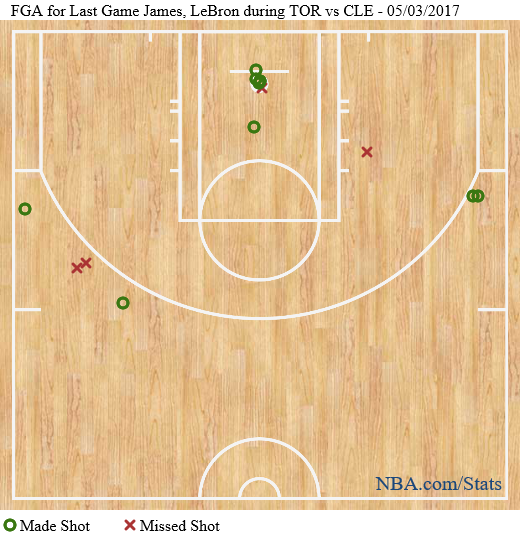Did Kawhi Leonard or LeBron James Have the Better Game 2 Performance?

You could say that Wednesday night wasn't of the nail-biting variety.
The Cleveland Cavaliers and San Antonio Spurs won their individual Game 2 matchups by 22 and 25 points, respectively. After the first five minutes, neither home team trailed for a single second.
Both were commanding wins by veteran, championship teams, and best of all, each squad was led by big games from their one-time Finals MVPs in LeBron James and Kawhi Leonard.
But which Game 2 performance was better?
By the Box
What can we gather from the box score?
| Player | PTS | REBS | ASTS | TOVS | STLS | BLKS |
|---|---|---|---|---|---|---|
| James | 39 | 6 | 4 | 3 | 3 | 2 |
| Leonard | 34 | 7 | 8 | 2 | 3 | 1 |
LeBron's shot was on, so he added points in bunches. In doing so, he passed Kareem Abdul-Jabbar for second all-time in playoff scoring and trails only Kobe Bryant in terms of points per game (34.2) through a 6-0 playoff start.
However, though James had more blocks, Leonard was the better overall contributor in the area of peripherals. In nearly 38 minutes, he ripped 7 rebounds along with an assist-to-turnover ratio of 8-to-2 while collecting 3 steals of his own on the defensive end.
Did you notice that Kawhi also scored 34 points? Well, all that's done is catapult him into first in Spurs history with 30.3 points per game through eight playoff contests.
"To each his own" is a very fitting statement here. But, with the help of Basketball Reference's Game Score metric, we can actually determine which player's box score performance was better. Game Score uses a formula of weights to provide a rough measure of a player's productivity for a single game. In brief, an outstanding score is 40 and an average score is 10.
This means that -- albeit both scores are near the level of outstanding -- Leonard's 37.8 Game Score is just a little greater than James' 36.0 by the raw numbers alone.
Beyond the Box
What happens when we throw efficiency into the conversation?
Beyond limited turnovers, James and Leonard both shot lights out from the floor. So much so that, between them, they missed just 7 of 30 attempts from the field and 3 of 10 from three, making for a joint effective field goal percentage of 88.3%!
Together, they were unbelievable. But, when we parse the two, they're just as spectacular.
| Player | FG% | 3P% | FT% | eFG% | TS% |
|---|---|---|---|---|---|
| James | 71.4% | 66.7% | 100.0% | 85.7% | 83.9% |
| Leonard | 81.3% | 75.0% | 71.4% | 90.6% | 93.4% |
Also, here's a side-by-side look at how those numbers look on the court.
According to numberFire Live -- our in-game live probability platform -- James and Leonard proved you can play a perfect game in two totally different ways. Their identical 100 ratings were the only two such performances on the night. One just happened to be a little more perfect than the other.
numberFire Live goes a step beyond a single rating by labeling each player performance with a nERD score, which measures a player's total contributions for the game, based on their efficiency. Much like Game Score, by this measure, Klaw's mark of 74.79 is marginally better than the King's 67.31.
In fact, Leonard's performance Wednesday night gave him his fourth perfect rating of the postseason. He's the only player to accomplish that, along with being the only one to earn a nERD of 70 or better. This was his third such game in eight contests and takes the place of his previous high of 74.44 set back in Game 1 in the Spurs' first-round matchup with the Memphis Grizzlies.
We can't deny that both players' Game 2 performances were great -- the numbers confirm it. But Kawhi looks like he's on a mission to prove his head coach's proclamation right -- that he is the best player in the game.


















